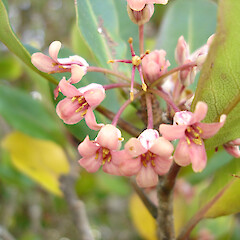Pittosporum umbellatum
Common name
haekaro
Synonyms
Pittosporum umbellatum Banks et Sol. ex Gaertn. var. umbellatum, Pittosporum umbellatum var. cordatum Kirk
Family
Pittosporaceae
Flora category
Vascular – Native
Endemic taxon
Yes
Endemic genus
No
Endemic family
No
Structural class
Trees & Shrubs - Dicotyledons
NVS code
The National Vegetation Survey (NVS) Databank is a physical archive and electronic databank containing records of over 94,000 vegetation survey plots - including data from over 19,000 permanent plots. NVS maintains a standard set of species code abbreviations that correspond to standard scientific plant names from the Ngä Tipu o Aotearoa - New Zealand Plants database.
PITUMB
Chromosome number
2n = 24
Current conservation status
The conservation status of all known New Zealand vascular plant taxa at the rank of species and below were reassessed in 2017 using the New Zealand Threat Classification System (NZTCS) – more information about this can be found on the NZTCS website. This report includes a statistical summary and brief notes on changes since 2012 and replaces all previous NZTCS lists for vascular plants.
Please note, threat classifications are often suggested by authors when publications fall between NZTCS assessment periods – an interim threat classification status has not been assessed by the NZTCS panel.
- Conservation status of New Zealand indigenous vascular plants, 2017 . 2018. Peter J. de Lange, Jeremy R. Rolfe, John W. Barkla, Shannel P. Courtney, Paul D. Champion, Leon R. Perrie, Sarah M. Beadel, Kerry A. Ford, Ilse Breitwieser, Ines Schönberger, Rowan Hindmarsh-Walls, Peter B. Heenan and Kate Ladley. Department of Conservation. Source: NZTCS and licensed by DOC for reuse under the Creative Commons Attribution 4.0 International licence.
2017 | Not Threatened
Previous conservation statuses
2012 | Not Threatened
2009 | Not Threatened
2004 | Not Threatened
Brief description
Small tree bearing flat smooth glossy green oval leaves and clusters of small pinkish or red flowers with a pale body on long stalks and 1.5cm wide capsules that split into two to show the black sticky seeds. Leaves 5-10cm long, ridged along upper surface.
Distribution
Endemic. New Zealand: North Island (North Cape to about Waihi, Tuhua (Mayor Island). Also locally near East Cape and Gisborne)
Habitat
Coastal forest and scrub. Often on offshore islands and rock stacks. Occasionally in lowland forest.
Detailed description
Small trees 3-12 m tall; branchlets greyish-brown to grey, young branchlets sparsely brown-tomentose soon glabrate. Leaves subverticillate, dark green adaxially, paler beneath, glabrous, coriaceous, margins thin, flat or slightly undulate, brown-pilose when young, thickened, revolute and glabrate when mature, nerves raised on both surfaces, usually brown to white-tomentose near base, secondary veins 8-15 per side, anastomosing, obscure above, distinct beneath. Juvenile leaves obovate to lanceolate, entire, occasionally crenate, sometimes deeply lobed or pinnatifid; adult leaves elliptic to oblong-lanceolate, entire, rarely crenate, acute or acuminate at apex, acute or attenuate at base, 25-100 x 15-50 mm, petioles 6-122 x 1-2 mm, brown-tomentose when young, glabrate. Inflorescences terminal, sometimes becoming lateral, umbellate, umbels up to 20-flowered; pedicels 4-25 mm long, accrescent in fruit, brown-tomentose, subtended by an approximate whorl of leaves and numerous caducous, glabrous, ciliate bud scales up to 12 mm long. Sepals slightly imbricate at base, lanceolate, acute to acuminate, 4.5-9.0 x 1.5-3.0 mm, sparsely ciliate; petals linear-oblong, subacute to obtuse, 11.0-12.5 x 2.5-5.0 mm, loosely coherent at the base, spreading from above the middle, dull red, pink, cream, white or yellow; stamens 4-8 mm long, anthers sagittiform to elliptic-oblong, 1.0-3.0 x 0.6-1.3 mm. Pistil at anthesis slightly shorter or longer than the stamens; ovary 2.5-3.5 x 1.0-3.0 mm, villous; style 3-4 mm; stigma capitate, obscurely 4-lobed or truncate. Capsules tetragonous or 4-lobed, 2(-3)-valved, 7-12 mm diameter, green to black, sparsely pubescent; valves concave in transverse section, < 1 mm thick, rim distinctly thickened, coriaceous; seeds 9-14 black, irregular.
Similar taxa
Easily recognised by the prescence of fine brown tomentum on the young branchlets (with the mature branchlets glabrous); leathery, glabrate, leaves up to 100 mm long, mostly 2-valved, tetragonous, deeply furrowed capsules and flowers which vary between plants from deep red through pink, cream and white to completely yellow.
Flowering
August - October
Flower colours
Cream, Red/Pink
Fruiting
Throughout the year
Propagation technique
Easily grown from fresh seed. Can be grown from semi-hardwood cuttings. Seed germination is often variable and this species although easily grown by some can be difficult for others. Probably some selection of suitable forms from the wild is needed
Etymology
pittosporum: Pitch seed
umbellatum: Bearing umbels
Attribution
Fact sheet prepared for NZPCN by P.J. de Lange 30 August 2006. Description adapted from Cooper (1956).
References and further reading
Cooper, R.C. 1956: The Australian and New Zealand species of Pittosporum. Annals of the Missouri Botanical Garden 43: 87-188
NZPCN Fact Sheet citation
Please cite as: de Lange, P.J. (Year at time of access): Pittosporum umbellatum Fact Sheet (content continuously updated). New Zealand Plant Conservation Network. https://www.nzpcn.org.nz/flora/species/pittosporum-umbellatum/ (Date website was queried)





